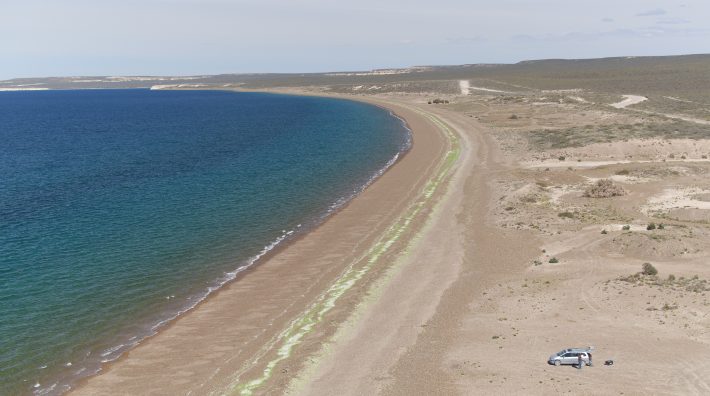Researchers have devised a way to accurately estimate the weight of free-living whales using only aerial images taken by drones. The method is presented in the British Ecological Journal Methods in Ecology and Evolution.
By measuring the body length, width and height of free-living southern right whales photographed by drones, researchers were able to develop a model that accurately calculated the body volume and mass of the whales.
Because of their large size and aquatic life, previously the only way to obtain data on the body mass of whales was to weigh dead or stranded individuals.
The innovative method can be used to learn more about the physiology and ecology of whales, “Knowing the body mass of free-living whales opens up new avenues of research. We will now be able to look at the growth of known aged individuals to calculate their body mass increase over time and the energy requirements for growth. We will also be able to look at the daily energy requirements of whales and calculate how much prey they need to consume.” said Assistant Professor Fredrik Christiansen from Aarhus Institute of Advanced Studies in Denmark and lead author of the study.
Dr. Michael Moore, a Senior Scientist at the Woods Hole Oceanographic Institution and co-author said: “Weight measurements of live whales at sea inform how chronic stressors affect their survival and fecundity, as well as enabling accurate sedative dosing of animals entangled in fishing gear that are aversive to disentanglement attempts.”
The model is already being used to assess the impacts of kelp gull harassment on the health and survival of southern right whale calves. Dr. Mariano Sironi and Dr. Marcela Uhart from the Southern Right Whale Health Monitoring Program and co-authors, emphasised “The use of drones to estimate whale weight and condition, as well as to individually track calves while they grow beside their mothers, has been a real breakthrough in our investigation.”
“In the past we’ve had to rely entirely upon stranded carcasses which added all sorts of uncertainties to our studies.
The model also allowed the researchers to collaborate with the Digital Life Project at the University of Massachusetts, USA to first recreate a 3D mesh of the whale, and then to work with CG artist Robert Gutierrez to recreate the full-colour 3D model of the right whale. These models can be used for both scientific purposes, such as studying movement, as well as for educational uses.
By adjusting the parameters of the model, the approach could be used to estimate the size of other marine mammals where alternative, more invasive, methods aren’t feasible or desirable.
Baleen whales, which include species like the blue whale, are the largest animals on this planet, with body mass being central to their success as an animal group. However, data on their size has historically been limited to dead specimens, with most samples coming from whaling operations, accidental fisheries bycatch or beach strandings.
Collecting data on dead whales has limitations such as being unable to collect longitudinal data over a whale’s life span and inaccuracies from physical distortion of carcasses caused by bloating and deflation.
Assistant Professor Christiansen explained that “The difficulty in measuring body mass reliably in free-living whales, has prevented the inclusion of body mass in many studies in ecology, physiology and bioenergetics. This novel approach will now make it possible to finally include this central variable into future studies of free-living whales.”

To calculate the body volume and mass of southern right whales the researchers first took aerial photos of 86 individuals off the coast of Península Valdés, Argentina. The clear waters and the large number of whales that gather there every winter for breeding made it an ideal place to collect high quality images of both the dorsal and lateral sides of the whales. From these they were able to obtain length, width and height measurements.
These measurements could then be used to accurately model the body shape and volume of the whales. “We used this model to estimate the body volume of whales caught in scientific whaling operations, for which body girth and mass was known. From these estimates of body volume, we could then calculate the density of the whales, which we in turn could use to estimate the mass of free-living whales photographed by our drones.” Said Christiansen.
Although the model yielded body mass estimates to a high-level of accuracy, there were some limitations due to the relative proportion of different tissues in baleen whales. Christiansen said, “We had to assume a constant body density of the whales, which is not realistic as the proportion of different body tissues (fat, muscle etc.) changes seasonally as the whales deposit or lose body condition.”
Read the article for free (for a limited time) here:
, , , et al. Estimating body mass of free‐living whales using aerial photogrammetry and 3D volumetrics. Methods Ecol Evol. 2019; 00: 1– 11. https://doi.org/10.1111/2041-210X.13298


